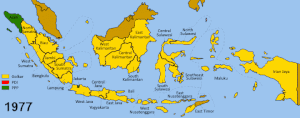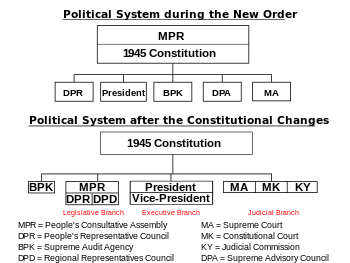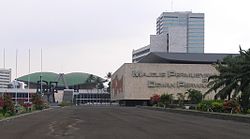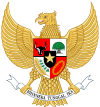| Revision as of 02:34, 8 March 2016 editAnomieBOT (talk | contribs)Bots6,590,846 editsm Dating maintenance tags: {{Use dmy dates}}← Previous edit | Revision as of 19:51, 5 April 2016 edit undo216.174.135.2 (talk) →The ReformationTag: repeating charactersNext edit → | ||
| Line 17: | Line 17: | ||
| Having served as rubberstamp bodies in the past, the DPR and MPR have gained considerable power and are increasingly assertive in oversight of the executive branch. Under constitutional changes in 2004, the MPR became a ], with the creation of the Dewan Perwakilan Daerah (DPD), in which each province is represented by four members, although its legislative powers are more limited than those of the DPR. Through his appointed ], the president retains the authority to conduct the administration of the government.<ref name="Denny265361441">Denny Indrayana (2008), pp. 265, 361, 441</ref> | Having served as rubberstamp bodies in the past, the DPR and MPR have gained considerable power and are increasingly assertive in oversight of the executive branch. Under constitutional changes in 2004, the MPR became a ], with the creation of the Dewan Perwakilan Daerah (DPD), in which each province is represented by four members, although its legislative powers are more limited than those of the DPR. Through his appointed ], the president retains the authority to conduct the administration of the government.<ref name="Denny265361441">Denny Indrayana (2008), pp. 265, 361, 441</ref> | ||
| A general election in June 1999 produced the first freely elected national, provincial and regional parliaments in over forty years. In October 1999 the MPR elected a compromise candidate, ], as the country's fourth president, and ] — a daughter of ], the country's first president — as the vice-president. Megawati's PDI-P party had won the largest share of the vote (34%) in the general election, while ], the dominant party during the Soeharto era, came in second (22%). Several other, mostly Islamic parties won shares large enough to be seated in the DPR. Further democratic elections took place in 2004 and 2009. | A general election in June 1999 produced the first fhnkjrjgknreiugbrkjgkrjogirgrbkjgbkjjkkjnj freely elected national, provincial and regional parliaments in over forty years. In October 1999 the MPR elected a compromise candidate, ], as the country's fourth president, and ] — a daughter of ], the country's first president — as the vice-president. Megawati's PDI-P party had won the largest share of the vote (34%) in the general election, while ], the dominant party during the Soeharto era, came in second (22%). Several other, mostly Islamic parties won shares large enough to be seated in the DPR. Further democratic elections took place in 2004 and 2009. | ||
| ] | ] | ||
Revision as of 19:51, 5 April 2016
For politics in Indonesia, see Politics of Indonesia.
The term Government of Indonesia (Indonesian: Pemerintah Indonesia) can have a number of different meanings. At its widest, it can refer collectively to the three traditional branches of government – the Executive branch, Legislative branch and Judicial branch . The term is also used colloquially to mean the Executive and Legislature together, as these are the branches of government responsible for day-to-day governance of the nation and lawmaking. At its narrowest, the term is used to refer to the Executive Branch in form of the Cabinet of Indonesia as this is the branches of government responsible for day-to-day governance.
History

The Reformation
A constitutional reform process lasted from 1999 to 2002, with four constitutional amendments producing important changes.
Among these are term limits of up to 2 five-year terms for the President and Vice-President, and measures to institute checks and balances. The highest state institution is the People's Consultative Assembly (MPR), whose functions previously included electing the president and vice-president (since 2004 the president has been elected directly by the people), establishing broad guidelines of state policy, and amending the constitution. The 695-member MPR includes all 550 members of the People's Representative Council (DPR) (the House of Representatives) plus 130 "regional representatives" elected by the twenty-six provincial parliaments and sixty-five appointed members from societal groups
The DPR, which is the premier legislative institution, originally included 462 members elected through a mixed proportional/district representational system and thirty-eight appointed members of the armed forces (TNI) and police (POLRI). TNI/POLRI representation in the DPR and MPR ended in 2004. Societal group representation in the MPR was eliminated in 2004 through further constitutional change.
Having served as rubberstamp bodies in the past, the DPR and MPR have gained considerable power and are increasingly assertive in oversight of the executive branch. Under constitutional changes in 2004, the MPR became a bicameral legislature, with the creation of the Dewan Perwakilan Daerah (DPD), in which each province is represented by four members, although its legislative powers are more limited than those of the DPR. Through his appointed cabinet, the president retains the authority to conduct the administration of the government.
A general election in June 1999 produced the first fhnkjrjgknreiugbrkjgkrjogirgrbkjgbkjjkkjnj freely elected national, provincial and regional parliaments in over forty years. In October 1999 the MPR elected a compromise candidate, Abdurrahman Wahid, as the country's fourth president, and Megawati Sukarnoputri — a daughter of Sukarno, the country's first president — as the vice-president. Megawati's PDI-P party had won the largest share of the vote (34%) in the general election, while Golkar, the dominant party during the Soeharto era, came in second (22%). Several other, mostly Islamic parties won shares large enough to be seated in the DPR. Further democratic elections took place in 2004 and 2009.

Executive branch
| Office | Name | Party | Since |
|---|---|---|---|
| President | Joko Widodo | Indonesian democratic Party-Struggle | 20 October 2014 |
The president and vice-president are selected by vote of the citizens for five-year terms. Prior to 2004, they were chosen by People's Consultative Assembly. The last election was held 9 July 2014. The president heads the Kabinet Kerja. The President of Indonesia is directly elected for a maximum of two five-year terms, and is the head of state, commander-in-chief of Indonesian armed forces and responsible for domestic governance and policy-making and foreign affairs. The president appoints a cabinet, who do not have to be elected members of the legislature.
Legislative branch


The People's Consultative Assembly (Template:Lang-id, MPR) is the legislative branch in Indonesia's political system. Following elections in 2004, the MPR became a bicameral parliament, with the creation of the DPD as its second chamber in an effort to increase regional representation. The Regional Representatives Council (Template:Lang-id, DPD) is the upper house of The People's Consultative Assembly. The lower house is The People's Representative Council (Template:Lang-id, DPR), sometimes referred to as the House of Representatives, which has 550 members, elected for a five-year term by proportional representation in multi-member constituencies.
Judicial branch
The Indonesian Supreme Court (Template:Lang-id) is the highest level of the judicial branch. Its judges are appointed by the president. The Constitutional Court rules on constitutional and political matters (Template:Lang-id), while a Judicial Commission (Template:Lang-id) oversees the judges.
State Auditor
The State Auditor (Template:Lang-id) is the high state body that responsible to check the management and accountability of state finances conducted by the Central Government, Local Government, other State Institutions, Bank Indonesia, State-Owned Enterprises (Template:Lang-id), Public Service Board (Template:Lang-id), Territory-Owned Enterprise (Template:Lang-id), and institutions or other entities that manage state finances.
See also
- Constitution of Indonesia
- Flag of Indonesia
- Administrative divisions of Indonesia
- List of Presidents of Indonesia
- List of Vice-Presidents of Indonesia
- Foreign relations of Indonesia
- Corruption in Indonesia
References
- Denny Indrayana (2008), pp. 360-361
- Denny Indrayana (2008), pp. 361-362
- Denny Indrayana (2008), pp. 293-296
- "Indonesia's military: Business as usual". 16 August 2002.
- Denny Indrayana (2008), pp. 265, 361, 441
- Denny Indrayana (2008), pp. 361, 443, 440
- Denny Indrayana (2008), pp. 264-265, 367
- Denny Indrayana (2008), p266 - 267
Further reading
- Denny Indrayana (2008) Indonesian Constitutional Reform 1999-2002: An Evaluation of Constitution-Making in Transition, Kompas Book Publishing, Jakarta ISBN 978-979-709-394-5
- O'Rourke, Kevin. 2002. Reformasi: the struggle for power in post-Soeharto Indonesia. Crows Nest, NSW: Allen & Unwin. ISBN 1-86508-754-8
- Schwarz, Adam. 2000. A nation in waiting: Indonesia's search for stability. Boulder, CO: Westview Press. ISBN 0-8133-3650-3
External links
| Indonesia articles | |||||||||
|---|---|---|---|---|---|---|---|---|---|
| History |
| ||||||||
| Geography | |||||||||
| Politics | |||||||||
| Economy | |||||||||
| Society |
| ||||||||
| Government of Asia | |
|---|---|
| Sovereign states |
|
| States with limited recognition | |
| Dependencies and other territories | |
